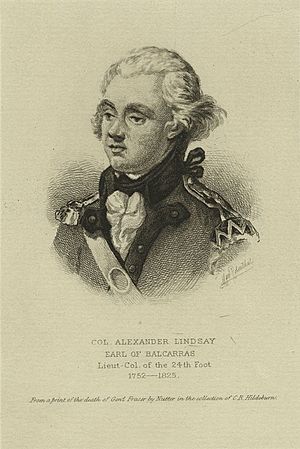Alexander Lindsay, 6th Earl of Balcarres facts for kids
Quick facts for kids
The Earl of Balcarres
|
|
|---|---|
 |
|
| Born | 18 January 1752 |
| Died | 27 March 1825 (aged 73) |
| Spouse(s) |
Elizabeth Bradshaigh Dalrymple
(m. 1780) |
| Children | 5, including James, the 7th Earl |
| Relations | James Lindsay, 5th Earl of Balcarres (father) |
| Military career | |
| Service/ |
British Army |
| Rank | General |
| Commands held | |
| Battles/wars |
|
Alexander Lindsay, 6th Earl of Balcarres (born January 18, 1752 – died March 27, 1825) was an important figure in the British Army. He was the son of James Lindsay, 5th Earl of Balcarres. He eventually became a General, which is a very high rank in the army.
Contents
Early Life and Army Start
Alexander Lindsay joined the army when he was just fifteen years old. He started as an ensign, a junior officer, in the 53rd Regiment of Foot. After studying at Eton College and the University of Göttingen, he bought a captain's position in the 42nd Highland Regiment in 1771.
He fought in the American Revolutionary War. In 1775, he became a major in the 53rd Regiment. He led the light infantry soldiers at the Battle of Saratoga in 1777. His forces surrendered there along with General Burgoyne. Alexander was released from being held captive in 1779.
Around this time, he also helped start the famous Haigh Ironworks. He did this with his brother Robert and James Corbett.
Family Life
On June 1, 1780, Alexander married his cousin, Elizabeth Bradshaigh Dalrymple. She had inherited Haigh Hall and its lands near Wigan, Lancashire. They had five children together:
- Elizabeth Keith Lindsay (died 1825)
- James Lindsay, 24th Earl of Crawford (1783–1869)
- Edwin Lindsay
- Charles Robert Lindsay (1784–1835)
- Anne Lindsay (died 1846)
Military Career and Public Service
After his release, Alexander was promoted to colonel. He became a leader of the second 71st Regiment of Foot in Scotland. In 1784, he was chosen to be a "representative peer" for Scotland. This meant he represented Scottish nobles in the British Parliament. He was re-elected for this role until 1807.
In 1789, he became the colonel of the 63rd Regiment of Foot. He was promoted to major-general in 1793.
Governor of Jamaica
From 1793 to 1794, Alexander was in charge of the forces in Jersey. Then, he was made the Governor of Jamaica. During his time as governor, the Second Maroon War began. This was a conflict between the British and the Jamaican Maroons, who were groups of people who had escaped slavery and formed their own communities.
Governor Balcarres had some difficulties managing the situation. A small land disagreement grew into a long and costly conflict. In 1795, he bought 100 Cuban bloodhounds to help track people. These dogs were used during the conflict, which caused a lot of debate and criticism in Britain.
Alexander underestimated the fighting skills of the Maroons. They were very good at guerrilla warfare, which is a type of fighting where small groups use surprise attacks. Eventually, one of his generals, George Walpole, convinced the Maroon leader, Montague James, to surrender. The Maroons were promised they would not be sent away. However, Balcarres went back on this promise. He sent the Trelawny Maroons to Nova Scotia.
After the war, Balcarres also tried to deal with another community of people who had escaped slavery, led by Cuffee. Many people who had fought with the Maroons joined Cuffee's group.
Alexander was promoted to lieutenant-general in 1798. He left his role as governor in 1801. On September 25, 1803, he was promoted to the highest rank, General.
Later Life and Legacy
After returning from the American Revolution, Alexander met Benedict Arnold. Arnold had led attacks against Alexander's position at Saratoga. Alexander saw Arnold as a traitor, and they had a duel, but no one was hurt.
Later in life, after an accident that caused him injury, he retired to his family home, Haigh Hall, near Wigan. When he passed away, his oldest son, James, became the 7th Earl. James later successfully proved his right to the title of Earl of Crawford in 1848. Because of this, the title was given to Alexander after his death, even though he had not claimed it himself.
His younger son, Edwin Lindsay, who was an army officer in India, faced mental health challenges. He was sent to Papa Stour in the Shetland islands. He stayed there for 26 years until a Quaker preacher named Catherine Watson helped arrange his release in 1835.
Memorial
There is a memorial for Alexander Lindsay in the Crawford chapel of All Saints' Church, Wigan. It describes his life and achievements.

